Introduction to Ali Qapu Palace
Ali Qapu Palace, located on the western side of Naqsh-e Jahan Square in Isfahan, holds the distinguished status of a UNESCO World Heritage Site. The talented architect Sheikh Bahai played a pivotal role in bringing this remarkable edifice to life. He did so under the authorization of Shah Abbas I during the Safavid dynasty.
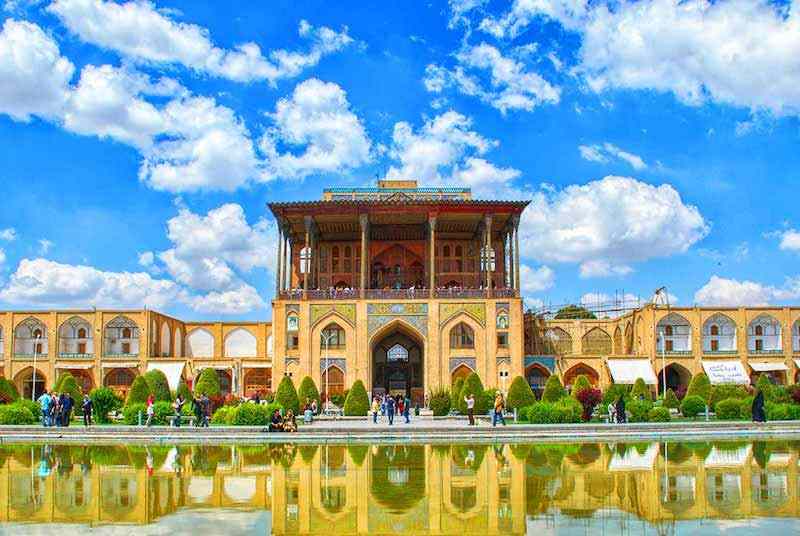
What truly sets Ali Qapu Palace apart is its remarkable architecture and towering height. Soaring to a majestic 48 meters with six stories and spanning 1800 square feet, it embodies the majesty of its era. Beyond its historical significance, this palace symbolizes the might and grandeur of the Safavid dynasty.
Today, Ali Qapu Palace extends an invitation to explore the rich Safavid history and architectural magnificence. In this article, we shall journey back in time to witness the beauty of this palace.
History of Ali Qapu Palace
Ali Qapu Palace holds a significant place in the history of Isfahan, dating back to the Safavid dynasty. It replaced the Timurid palace, which stood on this site 445 years ago, around 1000-1006 AH. Construction of this palace commenced 391 years ago, in 1054 AH, during the reign of Shah Abbas I.
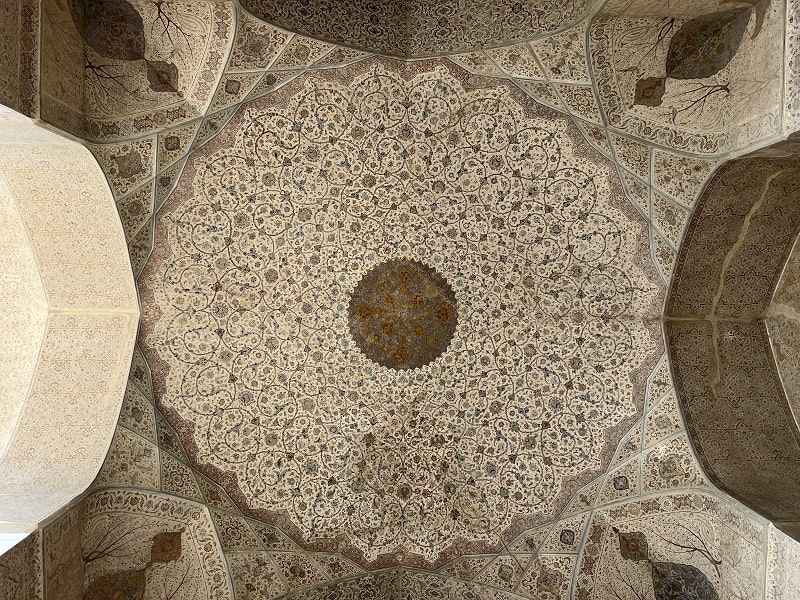
Early Construction and Development
While Shah Abbas I initiated the project, it was his successors, Shah Abbas II and Soltan Hoseyn, who oversaw its details and lavish decorations. This prolonged construction period spanned a century, reflecting the palace’s rich historical tapestry.
In its early construction, Ali Qapu Palace primarily served as a communication hub connecting Naqsh-e Jahan Square to nearby areas. The king and courtiers used it for ceremonies, welcoming foreign guests, and administrative functions. The palace featured a designated area for the king’s rest and other facilities. Additionally, the adjacent bazaar was initially a single-floor structure, and the entrance of the palace offered views of the prestigious bazaar shops.
Historical Significance
Ali Qapu Palace served as the backdrop for Shah Abbas I’s meetings with ministers and foreign ambassadors. Although initiated during his rule, the completion of this architectural masterpiece occurred after his reign. It’s evident in its interior arts, calligraphies, and miniatures, bearing witness to the legacies of subsequent Safavid kings.
This historical narrative makes Ali Qapu Palace a window into a bygone era, a symbol of the majesty of the Safavid dynasty that ruled over Iran for centuries.
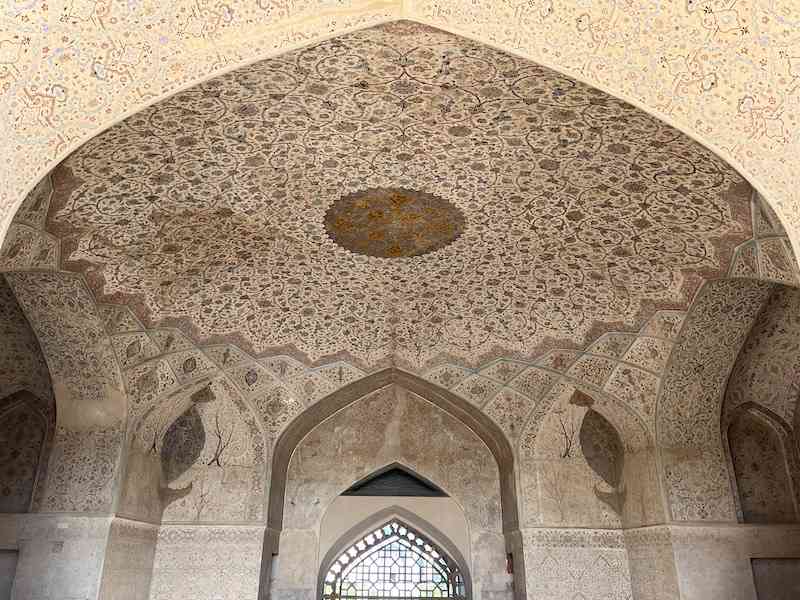
Ali Qapu Palace Chronicles & Transformations
As Isfahan expanded and its population grew due to its capital status, the significance of the government seat surged. To accommodate this, the number of floors at Ali Qapu Palace increased. In 1053 AH (392 years ago), during Shah Abbas II’s reign, a porch with 18 wooden columns, each 10 meters tall, was added to the third floor. Mirrors covered the columns, and the ceiling showcased large paintings. The walls received two decorative coverings: the first during Shah Abbas II’s reign and the second during Soltan Hoseyn’s rule.
Architecture of Ali Qapu Palace
Ali Qapu Palace stands as a prime example of Safavid-era architecture. Within its grand entrance gate, history unfolds. On both sides of the entrance, from the inside, there are two stone platforms. A little further stands the main building of the palace, and this part, considered as the distance between the entrance and the main building, is adorned with gabled arches. This space features intricate Arabesque motifs. One remarkable feature is its acoustics – when speaking softly in any of the corners, the sound travels clearly and loudly to someone standing in the diagonally opposite corner, a captivating phenomenon for visitors to experience.
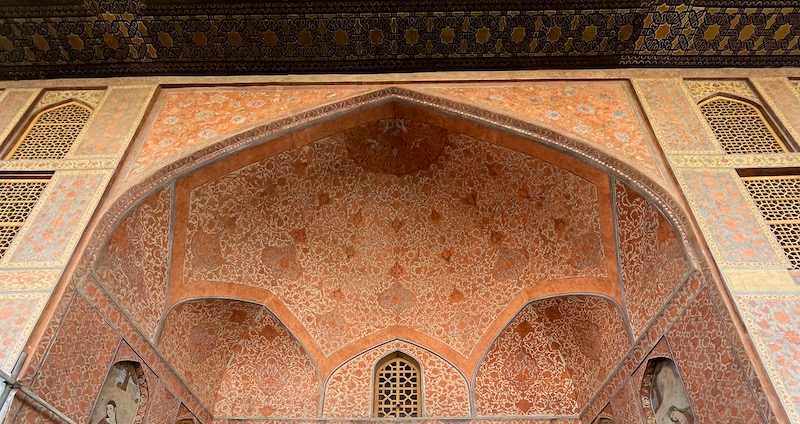
Ali Qapu’s Staircases and Floors
The ground floor of Ali Qapu Palace features dual spiral staircases for access to the upper levels. Each staircase includes 94 steps and leads to the top floor. The uniquely designed zigzag staircase on this level was exclusively used by the king and his family. Above Ali Qapu Palace, three floors comprise the structure, each divided into two, totaling six floors. However, the number of visible floors varies depending on the viewing angle: two from the east, five from the west, and seven from a special staircase used for royal events. Inside the palace, you’ll find spacious central rooms surrounded by smaller ones, creating a unique architectural layout.
The Music Hall
The music hall atop Ali Qapu Palace stands out in its architectural beauty, designed in a cross shape across 63 square meters. While adorning the walls, glass images and carved instruments create enchanting acoustics, filling the palace with melodious echoes. This design ensures that music resonates throughout the palace, making it one of its most captivating features. Meanwhile, Fred Richards, a renowned European painter, describes the stucco decorations in Islamic architecture as an intricate puzzle perfectly assembled. The music hall consists of three rooms; two are more spacious, and one is smaller.

Ali Qapu Palace’s music hall features unique paintings that depart from the palace’s traditional artwork. These paintings exhibit elements of Western artistic styles, setting a more modern tone in this part of the palace. The contrast in the artistic atmosphere makes it a distinct attraction within Ali Qapu Palace. In this part of the palace, you’ll vividly witness a fascinating fusion of art forms during your visit. To this day, this part of the palace remains a cherished gem, drawing admirers worldwide.
Innovative Water Supply System
Ali Qapu Palace includes a unique copper tank that ensured a steady water supply to its upper floors. Craftsmen skillfully employed stone and copper to create this fascinating reservoir, which functioned much like a lung, regulating the upper porch’s temperature. While this historic water feature is no longer operational, it shows the ingenuity of the past. The copper tank of the upper porch was a splendid achievement, built during the reign of Soltan Hoseyn, showcasing the engineering excellence of the palace.
The Pillared Porch
From the top floor of Ali Qapu Palace and its magnificent porch, Safavid kings and their guests used to watch polo games, fireworks, and festivals. The size of this pillared porch is about 480 square meters, and its floor is covered with wooden beams, which adds to the strength of the building. Following this, enhancements at the palace aimed to host guests, including a top-floor music hall with distinctive architecture and eye-catching decor.
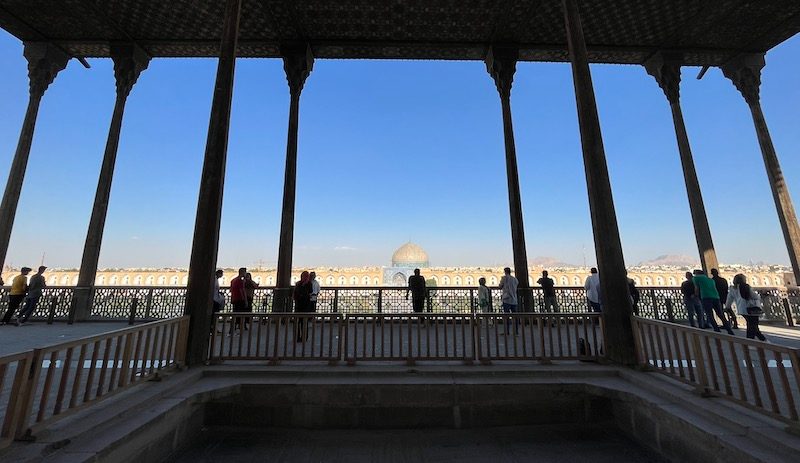
Structural changes expanded the porch facing Naqshe-Jahan Square, offering more space for events, ceremonies, and competition viewing. For that reason, the porch was extended seven meters beyond the bazaar shops and the palace’s entrance to accommodate guests and ceremonial parades. In conclusion, the palace porch features 18 pillars with a wooden roof, accessible via a long, narrow staircase. Ali Qapu Palace stands as evidence of the completeness of its era’s architectural achievements.
The Entrance Gate
Historically, the entrance to Ali Qapu Palace served as the link between Naqsh-e Jahan Square and other mansions, and it was referred to as ‘Government House Gate”. Historical records indicate that Shah Abbas I, after gifting a silver door to Imam Ali’s court in Najaf, relocated Imam Ali’s previous door to Isfahan. Currently, this historic door graces the entrance of the palace, giving it a special significance that continues to hold meaning for people today.
At present, Ali Qapu Palace’s entrance in the bustling Naqsh-e Jahan Square serves as a hub for visitors. Yet, the palace harbors not just one, but five distinct gateways. While the main entrance, celebrated for its grandeur, steals the spotlight, the other four portals, particularly in the past, offered pathways for those arriving from the surrounding areas and the nearby streets. These entrances include the majestic Ali Qapu, the northern-facing Four Pools Door, the City Gate Door overseeing the western gate, the Harem Door, and the impressive Front House Door leading to the palace’s kitchen.
Interior Design of Ali Qapu Palace
The interior decorations in Ali Qapu Palace stand out as captivating architectural features. Visitors can admire Iranian artistry from the entrance to the enchanting music hall. Each floor reveals unique decorations, showcasing intricate stucco decorations and exquisite paintings. In its splendid past, this palace graced visitors with its third-floor wooden columns, designed with exquisite mirrorwork. The porch ceiling featured wooden reliefs and artistic carvings. Beyond the porch lies a magnificent hall decorated with outstanding wall paintings, enhancing the building’s beauty.
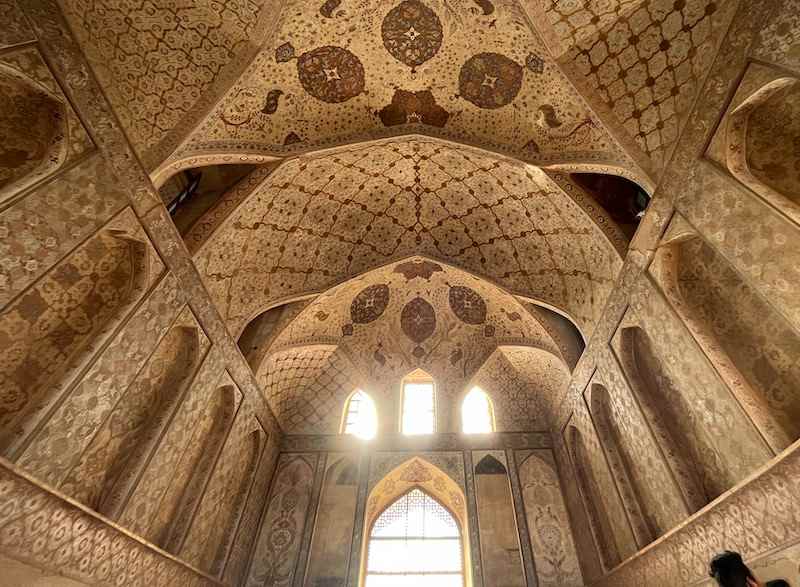
Reza Abbasi’s Legacy
The Safavid kings had a profound interest in painting, and Ali Qapu Palace houses significant historical artworks. Unfortunately, the lack of artist attribution and creation dates poses challenges for experts. However, within Ali Qapu Palace’s interior decorations, you can discover remarkable paintings by the renowned Safavid artist Reza Abbasi. While some have suffered damage, their remaining value is undiminished. The palace’s paintings feature captivating miniature images reflecting Iranian tradition and modern Western art. Reza Abbasi’s style graces the first, second, fourth, and fifth floors, while modern paintings adorn the third and sixth floors. Furthermore, a protective stabilizing solution safeguards the paintings.
Stucco, Muqarnas, & Illuminated Manuscripts
Ali Qapu Palace shows magnificent traditional decorations featuring seven-colored tiles, Arabesque art, floral and hunting motifs, and stunning stucco designs. The Safavid-era stucco work set a high standard for future architectural plasterwork, admired worldwide for its intricate, concept-rich patterns. Meanwhile, the interior stucco decorations exhibit the same captivating effect as the exterior adornments.
In addition, Ali Qapu Palace’s interior abounds with Muqarnas decorations, a hallmark of Islamic historical architecture. These Muqarnas structures exhibit a diverse array of shapes, from triangular to polygonal and even circular patterns.
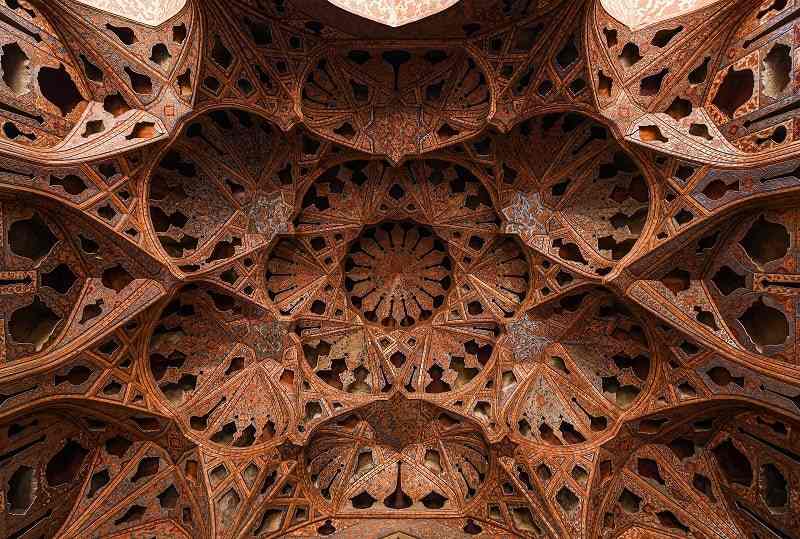
Embellishing Ali Qapu Palace’s interior, illuminated manuscripts grace its walls, arches, and ceilings, radiating captivating brilliance. This unique art style involves applying porcelain layers to specific areas, followed by a layer of gold, creating a captivating shine and beauty. The inscriptions and writings within Ali Qapu Palace detail the restoration undertaken during Soltan Hoseyn’s reign. Poems grace its walls, though many are damaged.
Nearby Attraction to Ali Qapu Palace
When you visit Ali Qapu Palace, you’re not just experiencing a historical building; you’re also in proximity to some of Isfahan’s most iconic landmarks. Within walking distance from the palace, you can explore the stunning Naqsh-e Jahan Square, a UNESCO World Heritage Site. Furthermore, in the grand Qeysarieh Bazaar (Isfahan Bazaar), you can immerse yourself in vibrant market scenes. Moreover, admire the Shah Mosque with its magnificent architecture, and step into the Sheikh Lotfollah Mosque with its enigmatic designs. These attractions, among others, make your visit to Ali Qapu Palace an unforgettable journey into the heart of Isfahan’s rich history and culture. It is called “Isfahan, Half of The World” for a reason and it’s a good one!
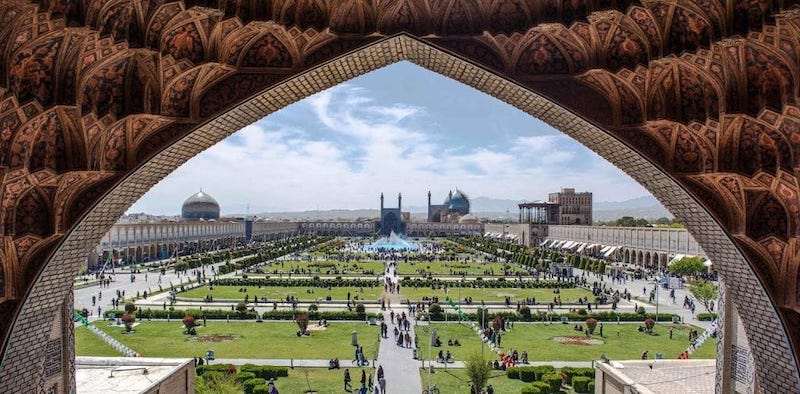
The Best Time to Visit Ali Qapu Palace
The best time to visit Ali Qapu Palace in Isfahan is during the spring and fall seasons. During these periods, typically from March to May and September to November, the weather is pleasant with milder temperatures. These seasons offer the perfect balance of comfortable weather and fewer crowds, allowing you to fully appreciate the palace’s architecture and history. While summer can be quite hot, and winter can be chilly, visiting during the shoulder seasons ensures a more comfortable experience.
A Guide to Visit Ali Qapu Palace
To fully appreciate historically rich sites like Ali Qapu Palace, it’s essential to invest time and immerse yourself in their beauty. We believe that this masterpiece, constructed over a century, deserves more than a brief 10-minute visit. While certain upper floors remain restricted from public access, you can still revel in the palace’s allure by leisurely strolling along its porch, connecting with the centuries-old wooden columns beneath your fingertips. Meanwhile, taking the time to absorb the craftsmanship, details, and ambiance of Ali Qapu Palace will enrich your cultural experience. Each step offers a chance to step back in time and savor the historical essence encapsulated in this work of art.
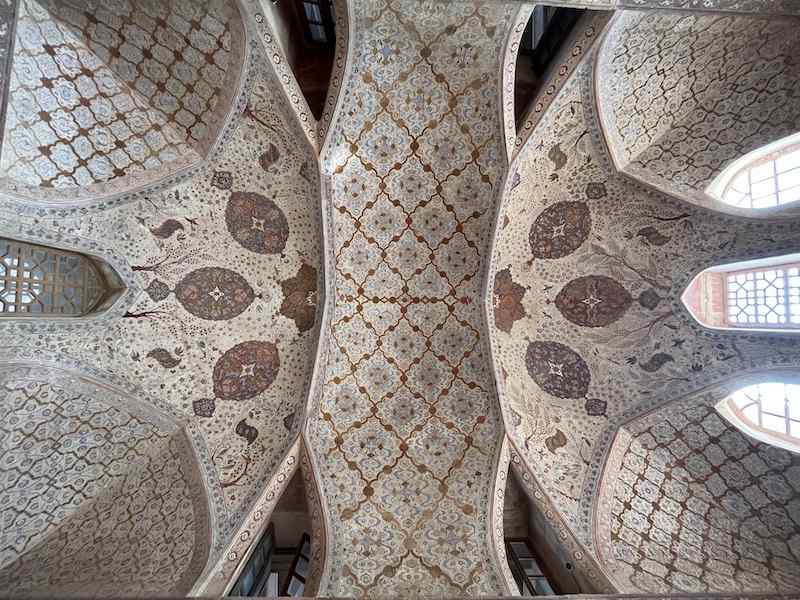
All The Eyes
Recognizing the endurance of a structure over nearly 500 years is no small feat. Contemplating the historical backdrop of the past five centuries is nothing short of enlightening. During the reign of the Safavid Dynasty in Iran, the Shia branch of Islam was disseminated throughout the nation. Consider the profound events witnessed by this architectural marvel — from the evolution of civilizations to global conflicts, the ascent and decline of innumerable monarchs, the ebb and flow of authority. It has observed the shifts in territorial dominions, all while preserving the echoes of decisions made within its hallowed confines for generations.
Ali Qapu Palace has borne witness to these epochs, standing steadfast amid the shifting tides of history. It has stood witness to the rise and fall of empires, from the Timurid dynasty to the Safavid Shahs, the Afsharid dynasty, Zand, Qajar, and Pahlavi dynasties, as well as Iran’s triumphs and tribulations. After enduring these momentous events and persisting through wars and calamities, its resilience imparts a soul and character to the edifice, elevating it from merely a building to a living, breathing pulse of history.
We believe that here lies an exceptional opportunity to explore one of the most magnificent architectural achievements of the Safavid era.

